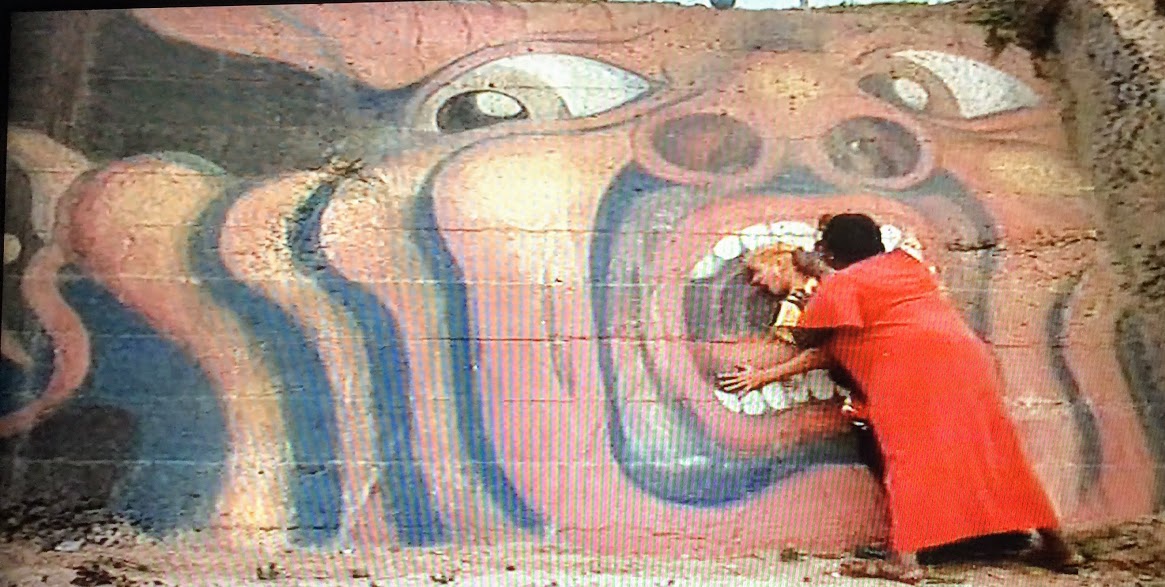
Review. Behold, my children. My magnum opus: Surf Nazis Must Die
More Videos
Published
4 years agoon
By
J.M. Brannyk
“There is no way that you are ever going to convince me that this is a good movie.” – My Glorious Spouse, 2020
Here we are, at the precipice of greatness. Finally.
Let me tell you a story. A love story.
Back in the old days of chunky rental boxes of VHS tapes, I remember first seeing the glistening box in the Horror section of Movie Mania. Back in those times, children, one would hitch up their horse and cart, traveling three miles in the snow, uphill, to rent a free horror movie every Monday night. And, after the arduous trek back, would blow the dust from the VCR player and jam that precious tape in to watch a hidden relic of the past. And it was worth it. It was damn well worth it.
One of those Mondays was very special for me and was the day I watched “Surf Nazis Must Die”. I fell in love – hard. I don’t want to say it changed my life, but here I am reviewing movies and getting paid, so you tell me, pal.
When I first met Glorious Spouse as an awkward teenager, this was a movie I shared on one of our dates. When I met new friends, I shared this. When I met GS’s friends, I shared this. It was not only a beautiful piece of schlock I admired to be shared, but also a litmus test; an endurance and reactionary experiment for me to gauge them. Did they see what I saw??? Could they feel what I felt?
No. Obviously. You saw the quote and obviously it wasn’t a deal-breaker, but it became the anathema I earned, as in, “Yeah, but you also think ‘Surf Nazis’ is good (so your opinion of movies is questionable)”.
Yeah, I did think it was good.
And you know what…I friggin’ still do.
So, my friends, let me try to open your mind and bring you into the nightmarish world of loss, madness, and revenge. In honor of Black History Month and in memory of Gail Neely, who played one of my favorite protagonists in all film history, I present to you: the review and exploration of Surf Nazis Must Die.

The Plot:
In the near future, a devastating earthquakes leaves the California coastline in shambles. The beaches are controlled by gangs, one of them being surf-friendly Neo-Nazis under the regime of “Adolf”, the self-proclaimed “Führer of the new beach”. Using the calamity and chaos to his advantage, he gathers the other gangs with the message of join his order or die on the sand.
During the same tragedy of the earthquake, widower Eleanor Washington has lost her only home. Her adult son helps her into her new residence, a senior home, where she finds it difficult to adapt. She’s seen as a trouble-maker and instigator – smoking, gambling and not being complacent in her new rigid and infantilizing atmosphere.
The two stories intertwine when Mama Washington’s son is viciously murdered by Adolf and his gang. After losing the only thing in her life, Mama begins her descent into anger, madness and revenge against those who took her son’s life. Let it be known that Surf Nazis must die!!!
The Nazis:
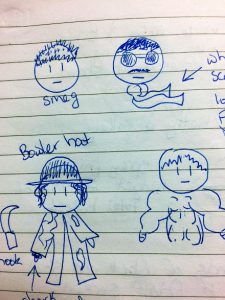
Most of the narrative is focused on the Surf Nazis and their interactions. Even the first shot is that of a young child, punk hair and cheeks painted with swastikas, shouting back cadenced authoritarian rhetoric to a stoic “Adolf”, within a group of other young children. Some of the Nazis have original Reich monikers like Eva, Adolf’s bitch (her words, not mine), and Mengele (the Valley-speaking Q who creates surfboard switchblades and whatnot). However, others do not share in the Nazi heritage: Brutus (the sensitive fighter), Hook (Alex from A Clockwork Orange meets Captain Hook), and Smeg (oh, I’ll talk about him later).
And then we have Adolf. Who is….dramatic. Laughably and adorably so. So much drama in this one. Drama and dreams. Dreams of leading all of the gangs of the beach (kind of like the beginning of Warriors, but as a Nazi d–head).
The Nazis live on the beach and in abandoned buildings, struggling through their existence by extorting other gangs, stealing from “normal” people, and eliciting the help of the young and dumb (we’ll get to Smeg, don’t worry). They are not powerful, really. They are sad. They are taunted by the other gangs. They sustain themselves by killing and eating wild pigs (?). And just as often as they band together, they tear each other apart. They are vicious and damaged. They are fumbling in their pursuit of power, and aimless in their violence. They have no agency, engagement, or efficacy.
The Mama:

Enter our protagonist. And yes, it could be easy to point out that there are certain characteristics, maybe even certain stereotypes, that are part of the “Mama” Washington character. She is a strong Black woman – Bible-carrying but is also sassy and sharp-as-tacks. She smokes cigars and gambles with her new friends at the senior home, telling them that she’s going to bring life into “them bitches”.
I admit, there are almost Madea-esque traits, but I would say whereas the usual Older Black Female character is sometimes a cruel, shrieking portrayal with a touch of bitterness, Gail Neely plays Mama with so much heart and warmth, it’s hard not to be endeared by her performance. There are some moments of audacity, but it’s never cruel; it’s at the core of the character. There are genuine moments of tenderness and vulnerability within her strength and conviction. Gail Neely brings such life and grit to this character. She is an unconventional hero and badass. Yes, this character was written by a white male, but I believe it was done so with endearment to the character and her role as victim and avenger.

And this is evident by the juxtaposition of her core concepts and motivations from the Nazis. She is the anti-Adolf. She is older. She is woman. She is Black. She is a nurturer and mother. She has purpose. She has agency. She has engagement with those around her. And you bet your sweet toots that she has efficacy. Mama Washington has power in her own life, even when she is deemed powerless (**see chainsaw vs tree scene**). She is the very opposite of Adolf and the Nazis, and it’s utterly surprising find something so rounded and in-depth in something so…Troma, let’s say?
The 21st Century Schizoid Man
There are really good shots in here. Really. Very clever camera work, no joke. I wrote that down a few times in my most recent viewing.
However, the most memorable and recognizable shot from the film is the Schizoid Man. In this incredibly dramatic point, Mama comes in first contact with one of the Nazis as he’s describing the death of her son. She grabs him and slams his head against a graffiti-painted wall. But it’s not just graffiti:

This is actually King Crimson’s album cover for 21st Century Schizoid Man, which is also featured as a song of general chaos, war imagery, death, destruction, and the desensitization of the human spirit from those elements. It was most likely written in response to the Vietnam War.
However, in this powerful moment, the art of the album is appropriated and re-contextualized. We see the pale head of a Neo-Nazi pushed against the mouth of a Black man, silently screaming in anguish. We see the older Black hand of a victim pushing the young and naïve racist perpetrator into that scream, into that direct confrontation of his superficial ideology and his subservient actions. During which, she becomes numb to the violence (and faceless) she is subjected and now a part of.

I could probably write forever about that scene. I could write forever about most scenes that feature Mama Washington because the incredible job that Gail Neely does. Let’s everyone take the day off of work to discuss how incredible her performances are!

The Homework: Thick Brain Roll Juice
I read up some for this one. I did my homework. Originally, I actually was going to argue that they aren’t really Nazis, but counter-culture, living in a depraved environment with limited resources because they are bored, “too hip” and white.
While some of that may be true (youpieceofcrapSmeg), the homework I did proved me wrong. Terrifyingly wrong.
It’s easy to watch this film for the laughs, for the fun, for the tie dye beach gang, Adolf’s awkward line reads, the gobs of slow-mo surfing, and Gail Neely’s poetic performance.
But the fact is that it’s not just a fun vacuum of cinematography and over-the-top acting. Watching this, it’s easy to dismiss this as a campy romp. Like I said, I was originally going to talk about turf wars and lack of seething resentment because they didn’t really strike me as Nazis. Assholes, yes. Nazis, no.
In fact, the very first paragraph of An Ethnographer Looks at Neo-Nazi and Klan Groups The Racist Mind Revisited by Raphael S. Ezekiel speaks exactly to that point and to my casual dismissal,
Americans today often learn about Nazis and the Ku Klux Klan through television clips of rallies or marches by men uniformed in camouflage garb with swastika armbands or in robes. These images often carry commentary implying that the racist people are particularly dangerous because they are so different from the viewer, being consumed by irrationality. The racists and their leaders are driven by hatred… Raphael S. Ezekiel
The same can be said for the films that we watch, Surf Nazis Must Die included. How Hollywood portrays the Nazi (Neo- or otherwise) changes over time. Our limited scope of understanding changes with those waves of popular culture, whether one is the impact of the other.
In a paper by Geoffrey Cocks entitled Hollywood Über Allies: Seeing the Nazi in American Movies, Cocks describes the road to Surf Nazis and beyond in the public cinematic sphere:
By the late 1960s, a skeptical, critical, and even cynical consciousness about the contemporary world had entered even Hollywood. Newly empowered teenage consumers and the Vietnam draft made the American film Nazi-unlike 1940s war films-big antiwar box office material because the Nazi now stood for any totalitarian oppression for young radicals outraged by American racism and the war in Vietnam. Bank of America became Bank of Amerika, and police became “fascist pigs.”
The 1970s in America brought a wave of still more problematic interest in Hitler, the Nazis, and the Holocaust, in which a mix of agnosticism, cynicism, hedonism, and nihilism prevailed over 1960s iconoclasm and idealism. The Nazi became a “floating signifier” for trivial fanaticism or madness: a “lawn Nazi,” a “feminazi,” a film demanding that Surf Nazis Must Die (Peter George, 1987)
From the 1980s on, ever more of international cinema hewed to the Flollywood-style entertainment movie. With the exception of a few films about American neo-Nazis, the Nazi and the German became less topical and central, even those about the war, and so tended to serve only the blandly realistic or the distantly metaphorical. But the Nazi yet retains his cinematic potency.
The weakness in Tarantino’s postmodern play is the weakness that had been growing and maturing in film ever since the Second World War: cinema grows so self-referential, so caught up in the economic conversation between Hollywood and American culture, that it ceases to be critically reflective. Cocks, Geoffrey. “Hollywood Über Alles: Seeing the Nazi in American Movies.” Film & History: An Interdisciplinary Journal, vol. 45 no. 1, 2015, p. 38-53. Project MUSE muse.jhu.edu/article/589137.
So, let’s dumpster-dive into the history a little to separate fiction and fact, or maybe even find some similarities. Before the 80’s, when this movie was filmed, the KKK was the anchor for much of the white power movement and didn’t mix with the emerging Nazi party in the US. But then the 80’s came with its Flashdances, Reaganomics, and Rubicks Cubes, and the two more or less started to merge into a smelly shitstain of grossness, and “concepts/symbols started being used indiscriminately between the groups“. (Ezekiel, pg. 52)
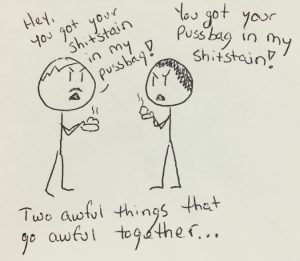
This happened partly because “some separatists feel that the old Klan is a ‘dinosaur,’ not aggressive and technical enough in its approach of asserting dominance and power. This view has led to the formation of other divisions of hate groups.” (Anderson, James F., Laronistine Dyson, and Willie Brooks Jr. “Preventing hate crime and profiling hate crime offenders.” Western Journal of Black Studies 26.3 (2002): 140) By 1994, (four years before Surf Nazi’s first DVD release) different watchdog groups estimated hard-core militant membership around 23,000 to 25,000, with approximately 150,000 sympathizers who subscribed to the ‘zines, and another 450,000 people who read the issues for the articles but didn’t buy. (Ezekiel, pg. 52-53)
During that time, between 1955 and 1998, white racists were responsible for more than a third of deaths related to domestic terrorism between, excluding the 168 individuals killed in the Oklahoma City bombing (Parkin, William S., et al. “Ideological Victimization: Homicides Perpetrated by Far-Right Extremists.” Homicide Studies, vol. 19, no. 3, Aug. 2015, pp. 211–236, doi:10.1177/1088767914529952.). And people of color are more often. Just in 1997, of the hate crimes committed, 8,049 bias-motivated criminal incidents were reported. Of these incidents, 4,710 were motivated by racial bias (Anderson).
But…but surfing! And….fun! And….switchblade surfboards! They just silly-billy Nazis!

Sure, let’s talk about the group – it’s dynamics and how it operates.
As previously mentioned, the first shot of the movie is at youth gathering with Adolf, establishing the supremacy of the Surf Nazis as the masters of the beaches. In fact, that the beach is in a bitter and bloody turf war, mostly because of the Nazis, which isn’t that surprising: “The movement makes its claim, in the ideology, to a turf and declares its role as defending that turf.” “…an ideology that glorifies toughness and fears tenderness or nurturance as weakness.” (Ezekiel) And we’ll circle back to the high tension created by them, too, so put a pin in that.
Let’s first talk about the one who pulls it all together. Even with his campy flair for the dramatic, Adolf still manages to manipulate and lead his group and terrorize the other gangs. This is well-put by Ezekiel in a few different sections:
The power to attract members comes from the leader’s certainty and his capacity with words and body to be the living expression of the resentment and anger of the listeners. Moreover, he can make his listeners feel that they are part of something that is happening, that these are not empty words.
In most cases, the leader is not extremely racist. Racism is comfortable for him, but not his passion. At core, he is a political organizer. His motive is power. Racism is his tool. He feels most alive when he senses himself influencing men, affecting them.
His disrespect includes his followers. He respects only those, friend or foe, who have power. His followers are people to be manipulated, not to be led to better self-knowledge.
We see this demonstrated in different ways, like the way he treats Eva, the way he beats Mengele, and his general indifference to the others. He is aloof, but intense, drawing on each group’s fears and insecurities…via drama!
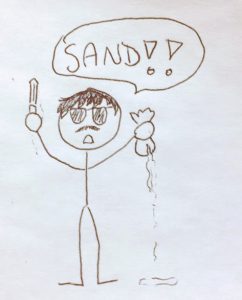
Now let’s talk about “Smeg”.
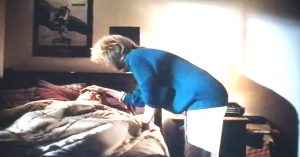
He’s also a piece of shit who comes from a loving, providing, un-apocalyptic home. His mom even tucks him in at night as he whines that he can’t go and play with Adolf and the rest. This is where you realize that civilization hasn’t crumbled. People still live in nice middle-class homes. People still go to work. People watch TV. People drink New Coke. People are existing and thriving, not living in the beach slums, eating wild (?) pigs. And to do so is by choice.
The apocalyptic backdrop is a facade as a means to an end. The disruption of the earthquake actually means very little, as any situation real or imagined, will have the message of apocalypse, as it is a means for Adolf to control and manage the group to do his bidding:
Any measure is justifiable in this war for survival. If innocent people die, it is unfortunate but a given in a war of survival. All this is heard repeatedly in leadership presentations, and its apocalyptic energy animates the larger movement gatherings. EZEKIEL, RAPHAEL S. “An Ethnographer Looks at Neo-Nazi and Klan Groups: The Racist Mind Revisited.” American Behavioral Scientist, vol. 46, no. 1, Sept. 2002, pp. 51–71, doi:10.1177/0002764202046001005.
American Nazism’s historic preoccupation with society’s decay and racial erosion demonstrates its anticipation of the arrival of a catastrophic new millennium.Brad Whitsel (2001) Ideological Mutation and Millennial Belief in the American Neo-Nazi Movement, Studies in Conflict & Terrorism, 24:2, 89-106, DOI: 10.1080/10576100117722
It’s not that the world is in chaos, the Nazi perceive and perpetuate the idea that the world is in chaos to justify their actions – whether its eating a wild pig (?), stealing a purse, or killing a Black man…
Let’s talk about Leroy’s Death (played by Robert Harden).
One study was particularly heartbreaking as it pieced a very tight puzzle to Leroy’s death in the movie to actual homicide victims of Neo-Nazis. Trigger warning; it’s really, really sad.
Victim–offender relationships show that 72.6% of victims had no prior knowledge of their killer(s)
99% [of racially targeted people] (or 59.2% of all victims) were killed because of something they represented, whether a specific race, religion, or even government. Here, the offender had no knowledge of the victim or their personal actions, only that they represented the population the offender was targeting.
Anti-race/ethnic minority victims were also killed more often by a knife, blunt object, or bodily weapon when compared with the anti-abortion and anti-government victims.
…almost 30% of anti-racial/ethnic minority victims were killed while walking or driving on the street.
These victims [racially motivated] had the most violent deaths. Often excessive force was used to beat them to death with blunt objects and bodily weapons. Mutilation and overkill were not uncommon.
The variance in overkill and modus operandi also could be a by product of a subculture of violence, such as those held by neo-Nazis and skinheads. Parkin, William S., et al. “Ideological Victimization: Homicides Perpetrated by Far-Right Extremists.” Homicide Studies, vol. 19, no. 3, Aug. 2015, pp. 211–236, doi:10.1177/1088767914529952.
So….now what?
This is a very real reality that is still happening to this day, especially as the growth of hate groups and crimes have increased dramatically over the US, and even more, that they are changing. They may not be huge groups, but they are influential groups and they evolve. As two researchers put it:
Social movements in the cultic milieu are by no means stable, nor do their beliefs or organizational patterns remain constant.Rather, groups in this constellation tend to be ephemeral and are governed by a lifecycle process. Over time, these collectivities ultimately fractionate and, in doing so, give birth to new groups. The process is cyclical and facilitates the recycling of ideas (and groups). This continual process of cult birth, reformation, and death suggests that the cultic milieu is a permanent part of society, while the individual cult is a transitory phenomenon. Brad Whitsel (2001) Ideological Mutation and Millennial Belief in the American Neo-Nazi Movement, Studies in Conflict & Terrorism, 24:2, 89-106, DOI: 10.1080/10576100117722
Low activity is not equivalent to no activity, particularly when white supremacist activity spikes in response to major social change like the election of the country’s first black president. Cooter, A. (2011), Neo‐Nazi Nationalism. Stud Ethn Nation, 11: 365-383. doi:10.1111/j.1754-9469.2011.01126.x
As fun and campy as this movie is, it is based on fact and fantasy. Unfortunately, in real life, Mamas don’t get to but guns that “take a head off a honkey in twenty paces” and exact revenge. They exist in a culture that created the killer and perpetuates racism (whether loud or quiet) via complacency and institutionalized undertones. And do so, in our norms and conventions, silently.

And it’s easy to be complacent and to not understand the institutional affect when you’re far-removed. It’s a understandable reaction to watch this movie and not identify with any of the Nazis because they are so extreme. They cannot be us. We don’t kill people. We don’t paint swastikas on our surfboards.

But…I just want to have fun and watch my movie 🙁
Of course watch this movie and have fun! Watch the hell out of it – I love it! Remember, this is a love story. Enjoy the camp, enjoy the revenge and goofy surfing. It’s there for you to enjoy and love as your own.
But it’s also a great moment to contemplate, to take a step back and think, especially for us honkeys (we honkeys?). Some great advice for this can, of course, be found in multiple sources, but taking from Ezekiel’s final thoughts on the matter in his paper on Neo-Nazism in America:
Probably the greatest effect of White racism today is its capacity to slow institutional change. Policies that help institutional racism to continue to flourish do much more to hurt minority people than do hate crimes.
And it is worth noting that the neo-Nazis are not totally alien to White Americans. A social attitude does not exist in the mind as an isolated single entity. Real attitudes, or orientations, are laid down throughout life in layer after layer.
The task is to get acquainted with those layers of oneself—to learn to recognize them and not be frightened by them. It is not a disgrace to have absorbed some racism. It is a disgrace not to know it and to let those parts of ourselves go unchecked.
It’s easy not to have a switchblade swastika board, but it’s becomes convoluted if you defend saying the n word, or roll your eyes at #whiteoscars. Its the latter that fuels the former and is the foundation on which its built.
The Bottom-line:
Oh…you’re still here? That’s surprising.
 (5 / 5)
(5 / 5)
Don’t judge me.
When not ravaging through the wilds of Detroit with Jellybeans the Cat, J.M. Brannyk (a.k.a. Boxhuman) reviews mostly supernatural and slasher films from the 70's-90's and is dubiously HauntedMTL's Voice of Reason. Aside from writing, Brannyk dips into the podcasts, and is the composer of many of HauntedMTL's podcast themes.

You may like
3 Comments
Leave a Reply
Cancel reply
Leave a Reply
This site uses Akismet to reduce spam. Learn how your comment data is processed.
Amazon Prime’s Fallout has continued to be a suspenseful delight. And with the last episode’s dramatic cliffhanger, I was certainly looking forward to this one.
Thankfully, it did not disappoint.
The story
We start our story with Lucy and Maximus waking up in a decontamination room in Vault 4. They’re welcomed guests, once they’re done with decontamination.
Vault 4 at first seems very much like Vault 33 to Lucy. She’s surprised, however, to find that a lot of people who live there are actually from the surface. And the people who live in this vault are, well, a bit mutated. Their overseer, named Benjamin and played by the hilarious Chris Parnell, has just one eye in the middle of his face. Some people have extra limbs or missing ones. And yet it’s clear that everyone’s living together in peace and companionship.
At least, that’s what it’s supposed to look like. There is, after all, the matter of the weird cult the surface dwellers seem to have formed. And, the small matter of the vault level no one is supposed to go to. It should come as no surprise that, of course, that’s exactly where Lucy finds herself before the episode is over.
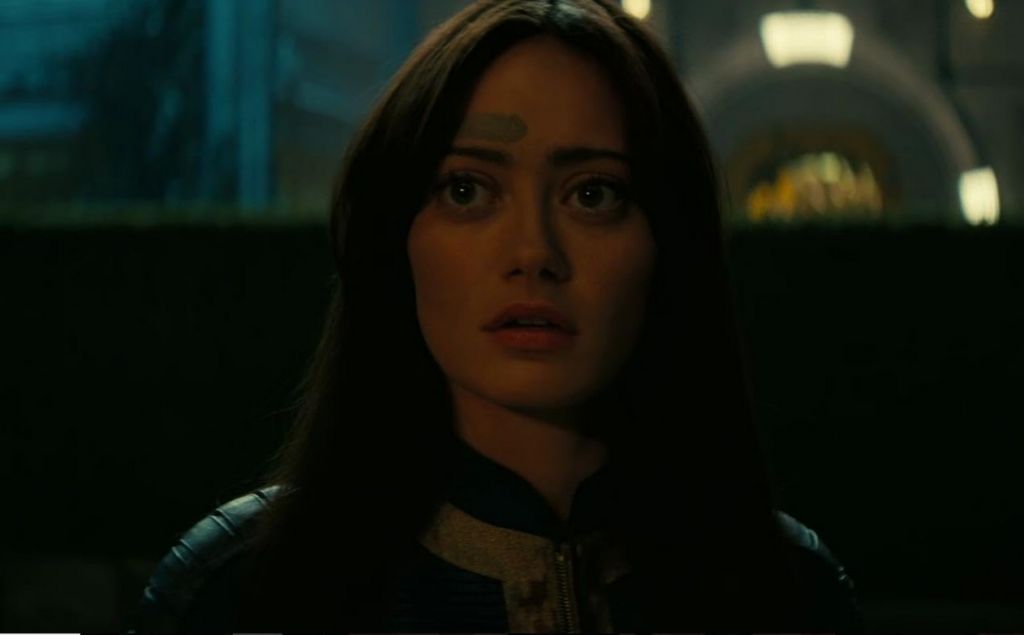
Of course, this episode wouldn’t be complete without checking in with the Ghoul. And his part of the story is, honestly, more compelling.
We see him apprehended by people referring to themselves as The Government. And while he appears to be a prisoner, it’s clear soon enough that he’s the one in charge.
Far more compelling are his flashbacks to his past. While his wife, Barb, is starting to be more secretive, he learns more than he wants to about Vault Tec. He also learns that the Communist party in Hollywood might know more about what Barb does for a living than he does. And it’s clear soon that she never wanted him to know.
For good reason.
What worked
I first want to draw attention to the excellent way we are learning about the Ghoul. As we learn more and more about his past, we can see how he’s become the monster he is today. It’s clear that once upon a time he had everything he could want. A lovely home, a family he lived for, and a successful career. And he lost all of that, even his dog. And with those losses, he lost his humanity in more ways than one.
But I also think we’re seeing signs that his humanity at least isn’t as lost as he thought it was.
On a lighter note, I loved Maximus’s response to the vault. While he’s apprehensive at first, he is swept away by the welcome basket. He’s lived his whole life hungry, barely surviving, and suddenly he has food. Good food. Caviar and oysters. He has a warm robe and TV and a safe place to exist. It must have been like stepping into a fairy tale for him. And while it wasn’t exactly helpful for Lucy, it’s completely relatable that he decided to sink into a chair and have a snack in front of the TV for a while.
What didn’t work
While this episode was mostly good, I do have one complaint. When Lucy is first meeting with Overseer Benjamin, we see him accidentally drinking a cup of coffee that has gotten moldy.
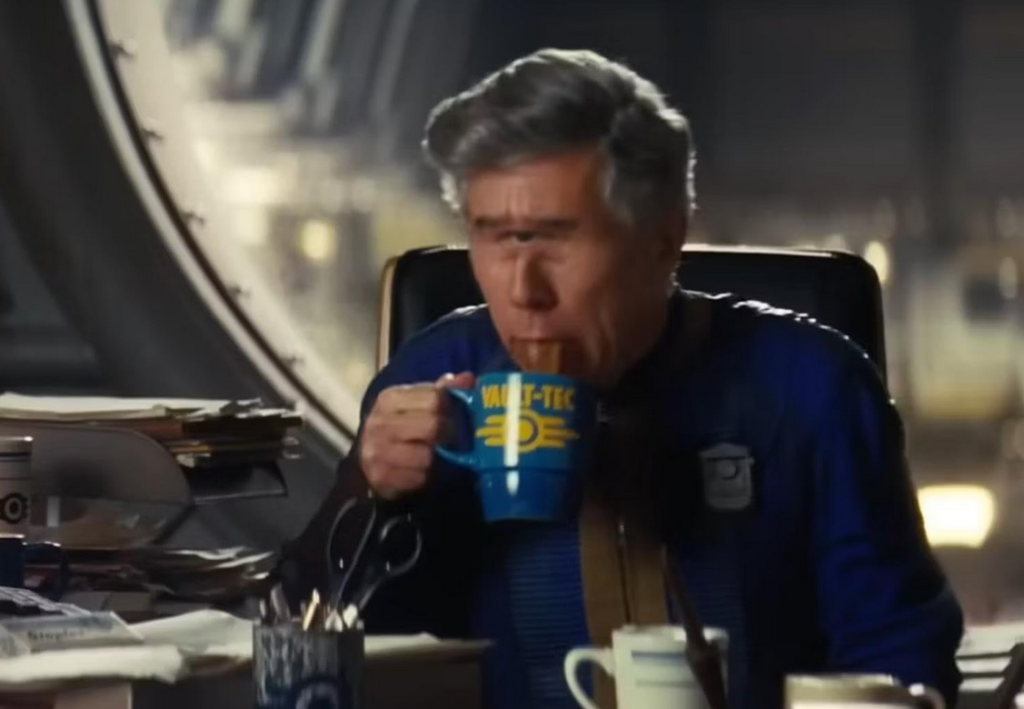
Now, this makes perfect sense in our world to convey someone too busy and forgetful to clean up old mugs. But it’s hard to fathom someone living in a Vault in which every resource is carefully monitored, letting something like coffee go bad. It’s a small detail, and it was funny. Also more relatable than I’d like to admit. But in this instance, in this world, it was jarring.
So far this season has been intense. There’s a lot of intrigue and mystery. There’s a lot of high emotions. And there’s a lot on the line for everyone. Maybe, for one character, more than we’ve ever realized before.
Good thing we still have two episodes to discover what’s happening.
 (4 / 5)
(4 / 5)
If you like my work, you can check out my latest science fiction/horror novel, Nova, launching on May 17th. Pre-orders are available now on Amazon.
Related posts:
Episode four of Amazon’s Fallout wasn’t the best-liked. Of course, that’s relative to the rest of the season. While this is the second-to-last-ranked episode, it’s still an 8.1 on IMDB.
So let’s talk about why it might have slipped a bit but was still a great episode of TV.
The story
Let’s start our discussion of this episode with Maximus.
After he and Thaddeus successfully retrieved the head from the Gulper, they’re in high spirits. Together they celebrate around a fire, giving a lovely impression of two people who have been drinking despite not seeing a bottle in sight. Thaddeus even convinces Maximus to brand him.
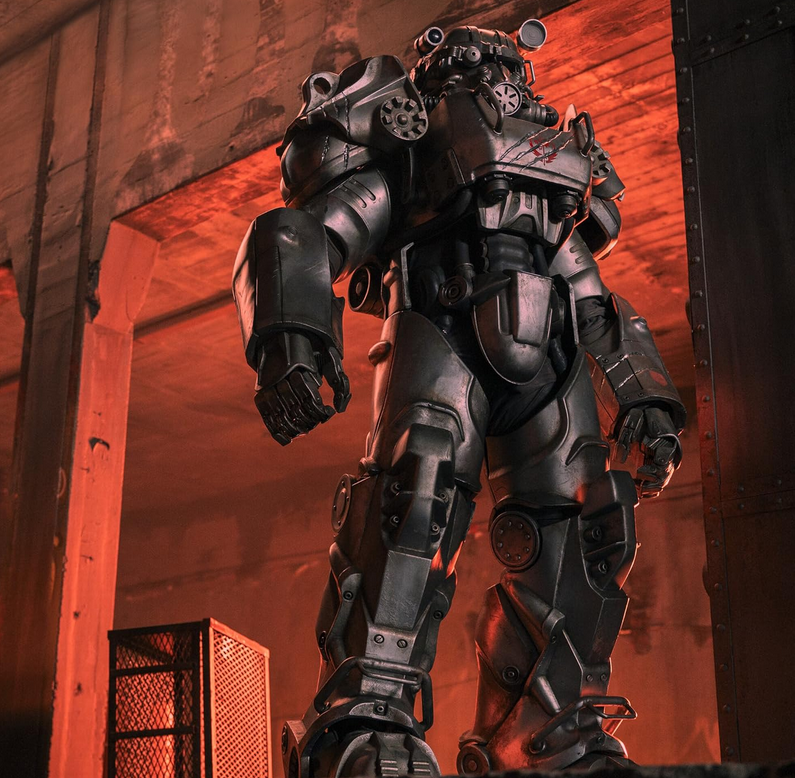
While having a good time, Maximus’s consciousness gets the better of him. He admits to Thaddeus that he’s not Knight Titus, but he is Thaddeus’s old punching bag.
Rather than responding to this act of honesty with an equal measure of grace and brotherhood, Thaddeus immediately disables Maximus’s suit, taking the power source and the head. He then leaves Maximus trapped in the suit that he wanted so much, doomed to die in it.
Lucy isn’t in a much better place. If you’ll recall, last episode she drank radiated water out of desperate thirst. She’s now suffering from radiation poisoning. Fortunately, before she succumbs to this poison, she finds Maximus. He has the medicine she needs, and she can free him from his suit before he’s eaten by giant cockroaches. It seems like a win/win. If that is, the two of them can trust each other. And haven’t they both learned that trusting other people might be the most dangerous thing in this very dangerous world?
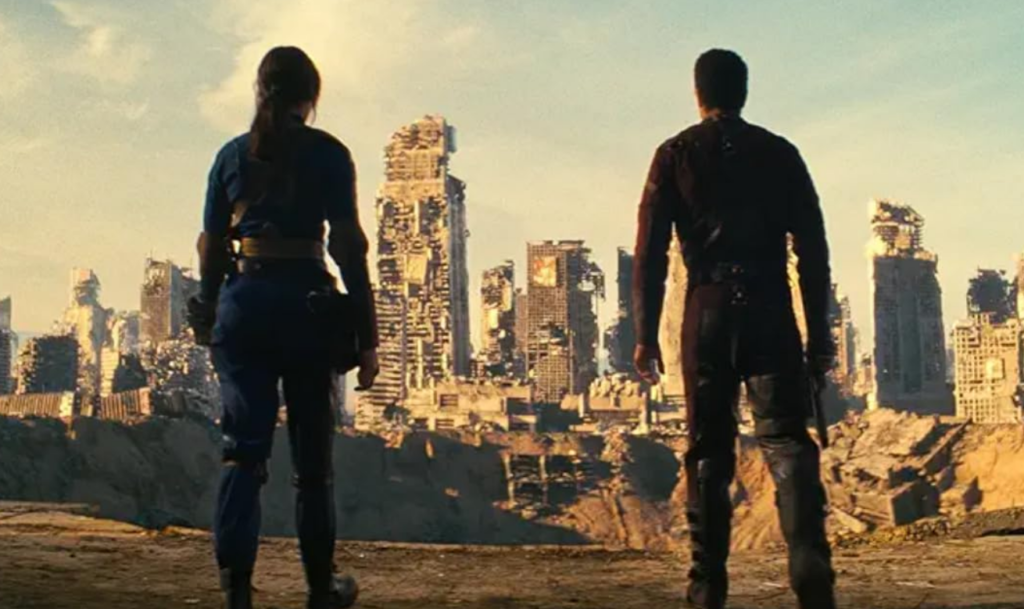
What worked
The first thing I want to draw attention to is the relationship between Lucy and Maximus. A lot has happened since the last time the two saw each other when there were some sparks but no time to do anything about them. Both have been betrayed and hurt. So while they’re instinct is clearly to trust each other, it’s also to be cautious. And that makes sense. They are both good people, driven by the desire to help others. But both are cautious of being hurt again.
This was not only relatable, but it gave a much different feel to a standard will they/won’t they relationship. Will they be able to trust each other enough to let their feelings out is the real question. Which is a lot more interesting, in my opinion.
I also found the giant, mutated bugs to be fantastic. They were the perfect blend of cute and terrifying. At first glance, they seem like a larger version of Hal from Wall-E. Then, you realize how few of them it would take to eat someone trapped in place. And how little time it might take.
And how long it might feel like while it’s happening.
We don’t need to see that happen to feel the terror there. And to feel some concern about the tiny pests that sometimes share our homes.
Of course, the highlight of this episode was the political intrigue surrounding Vault 33, and how its leaders always seem to be from Vault 31. This storyline is quickly becoming my favorite part of the season. It’s a dark and creepy mystery, which is always fantastic. But it’s also fascinating to see the character of Norm blossoming into someone whose life has meaning. Because at the start of the season, he was lacking that.
All in all, while this was a slower episode it was still a good one. And its ending certainly left me excited for what was to come.
 (4 / 5)
(4 / 5)
If you like my work, you can check out my latest science fiction/horror novel, Nova, launching on May 17th. Pre-orders are available now on Amazon.
Movies n TV
Bodies Bodies Bodies (2022), a Film Review
Bodies Bodies Bodies (2022) is a horror comedy directed by Halina Reijn. This R-rated horror film stars Amandla Stenberg and Maria Bakalova.
Published
1 week agoon
April 29, 2024
Bodies Bodies Bodies (2022) is a horror comedy directed by Halina Reijn. This R-rated horror film stars Amandla Stenberg, Maria Bakalova, Myha’la, Rachel Sennott, Chase Sui Wonders, Pete Davidson, Lee Pace, and Conner O’Malley. The film is currently available on fuboTV, Netflix, Hoopla, and Showtime.
Sophie (Amandla Stenberg) brings her girlfriend (Maria Bakalova as Bee) to her friend’s hurricane party. Lasting resentment and toxic relationships infest the group, leaving Bee to witness increasingly uncomfortable situations. Soon after, bodies start dropping.
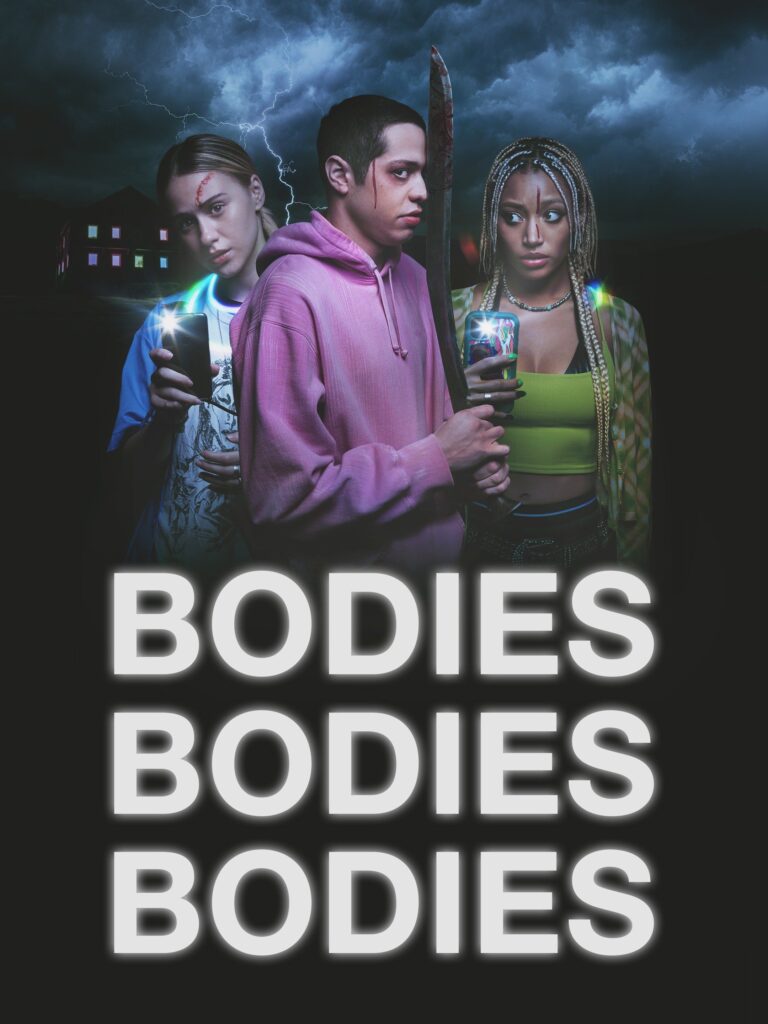
What I Like about Bodies
The chemistry between these toxic friends gives me anxiety. If toxic friendships aren’t a universal experience, toxic traits certainly make themselves apparent in any friend group, and this film maximizes this experience. It’s not revolutionary, but effective and uncomfortable.
Several subtle clues hint at the relationships of these friends, building up as the story progresses and chaos ensues. I love these moments, though the film doesn’t seem confident that the viewer picks up these clues. This decision hinders execution, an unfortunate point for later.
While the performances are strong throughout, Amandla Stenberg and Maria Bakalova remain the main characters and receive the most opportunities to perform. However, almost every character has a moment, or several, and lives up to those moments once given.
The twist seems obvious, but that doesn’t hinder the viewing experience. While not the biggest fan of the execution, I enjoy the spiraling chaos it creates.
The opening scene shows the two leads making out for viewer engagement. However, I think the contract toward the end gives this scene added context and plot relevance beyond simply sex appeal. While it is unavoidable that so well, many films will go no further. So, added relevance deserves a nod.
Far from the bloodiest film out there, but it doesn’t hesitate to bleed its cast. It uses this blood and limited gore to add weight to the deaths as opposed to haunting or nauseating its audience.

Tropes, Triggers, and Considerations
As previously hinted, toxic relationships remain key points in the plot. Falling in line with this are points of spousal abuse (physically and mentally) that should remain a consideration.
Idiocy to push the plot along certainly plays a role in the plot. In this case, I consider it a feature. However, it’s still a required taste for viewer consideration.
Addiction and recovery drive several characters. I’ll avoid pointing to them so as not to give away plot details. However, usage and relapse deserve a mention in this section.
If any of these are deal breakers, give this film a skip.

What I Dislike, or Food for Thought, about Bodies
Bodies shifts between a mindless and clever horror comedy, never comfortably sticking to one or the other. It pulls off elements of both with expertise, but the tugging and pulling of these different elements limits the execution of either. Because of the above friction, Halina Reijin gives us all the clues to piece everything together and still tells us. Pick an audience and trust them.
As a horror comedy, this film leans on the humor over the horror. The unraveling of characters certainly earns respect but expect a comedy for a better experience. It’s not a particularly scary film, and it doesn’t try to occupy that space.

Final Thoughts
Bodies Bodies Bodies spirals into a chaotic horror comedy, banking on the toxic chemistry of its cast to deliver both. The film never makes a strong stance in either claiming a mindless or clever horror comedy, shifting between both at the expense of the whole. It remains a bumpy but engaging viewing experience, nonetheless. (3 / 5)
(3 / 5)


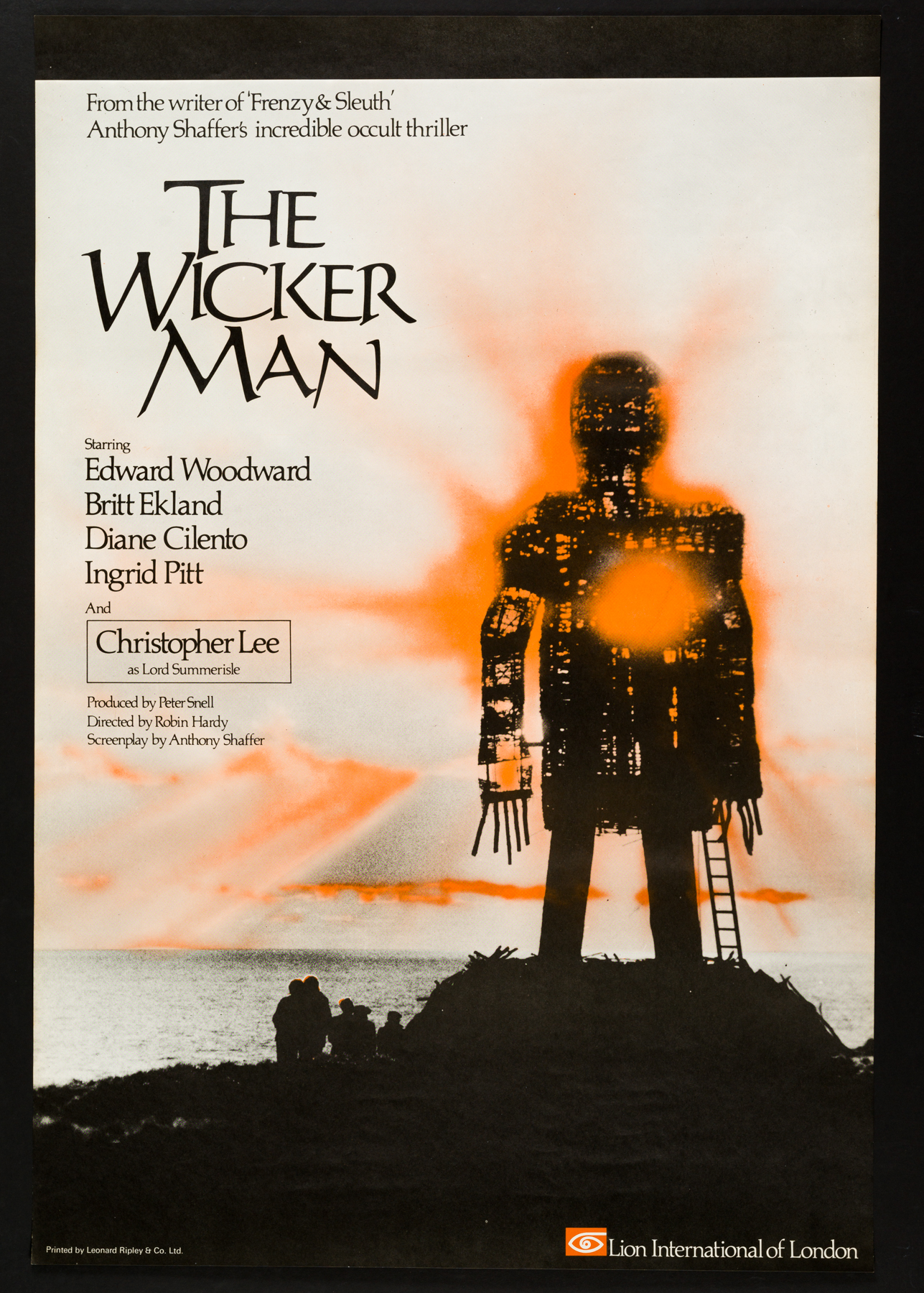

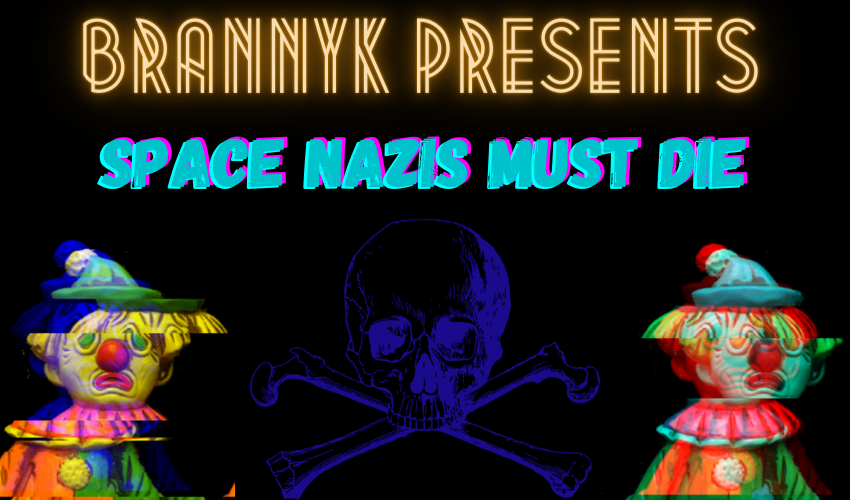




John Combo
February 29, 2020 at 12:54 pm
Even the trailer is awesome! They actually put this in line with The Road Warrior and The Terminator! I’m not even sure if they weren’t trying to be serious! Awesome review!
Patricia Dartt
March 1, 2020 at 2:56 pm
Awesome review. Actual thought on the movie not just glossed over fun or not fun. Not just talk about the visual aspects or acting. I like that you really researched here. You also mentioned the typical acting and cinematography and fun factors anyone would expect. Good job.
Pingback: When Films Go Too Far I Can Help - Haunted MTL